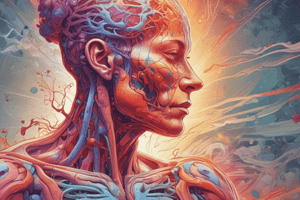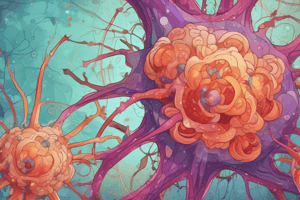Podcast
Questions and Answers
Which of the following is NOT a cardinal sign of inflammation?
Which of the following is NOT a cardinal sign of inflammation?
- Calor
- Tumor
- Pallor (correct)
- Dolor
Which component is primarily responsible for the vascular response during inflammation?
Which component is primarily responsible for the vascular response during inflammation?
- Fibrin
- Neutrophils
- Leukocytes
- Histamine (correct)
What characterizes chronic inflammation compared to acute inflammation?
What characterizes chronic inflammation compared to acute inflammation?
- Presence of giant cells (correct)
- Short duration
- Rapid response
- Dominance of polymorphs
Which type of injury is NOT listed as a cause of inflammation?
Which type of injury is NOT listed as a cause of inflammation?
In acute inflammation, what is the primary immune cell involved in the response?
In acute inflammation, what is the primary immune cell involved in the response?
What is the primary factor that distinguishes exudate from transudate regarding capillary permeability?
What is the primary factor that distinguishes exudate from transudate regarding capillary permeability?
Which statement accurately describes the composition of exudate?
Which statement accurately describes the composition of exudate?
Which factors influence the amount of inflammatory exudate produced in tissue?
Which factors influence the amount of inflammatory exudate produced in tissue?
Which of the following best describes the appearance of transudate compared to exudate?
Which of the following best describes the appearance of transudate compared to exudate?
What type of fluid is primarily characterized as an ultrafiltrate of blood plasma?
What type of fluid is primarily characterized as an ultrafiltrate of blood plasma?
Flashcards
Transcytosis
Transcytosis
Movement of molecules across a cell, mediated by vesicles and vacuoles.
Inflammatory Exudate
Inflammatory Exudate
Fluid with high protein content, inflammatory cells and debris, caused by increased capillary permeability.
Vascular Permeability
Vascular Permeability
Increased leakiness of blood vessels, allowing fluids and proteins to leak out into tissues.
Capillary Hydrostatic Pressure
Capillary Hydrostatic Pressure
Signup and view all the flashcards
Osmotic Pressure
Osmotic Pressure
Signup and view all the flashcards
Transudate
Transudate
Signup and view all the flashcards
Exudate
Exudate
Signup and view all the flashcards
Capillary permeability (increased)
Capillary permeability (increased)
Signup and view all the flashcards
Inflammation Definition
Inflammation Definition
Signup and view all the flashcards
Inflammation Aim
Inflammation Aim
Signup and view all the flashcards
Acute Inflammation Definition
Acute Inflammation Definition
Signup and view all the flashcards
Cardinal Signs of Inflammation
Cardinal Signs of Inflammation
Signup and view all the flashcards
Acute Inflammation Vascular Response
Acute Inflammation Vascular Response
Signup and view all the flashcards
Causes of Inflammation
Causes of Inflammation
Signup and view all the flashcards
Suppurative Inflammation
Suppurative Inflammation
Signup and view all the flashcards
Chronic Inflammation
Chronic Inflammation
Signup and view all the flashcards
Vascular Responses (Immediate)
Vascular Responses (Immediate)
Signup and view all the flashcards
Vascular Response (Endothelial Changes)
Vascular Response (Endothelial Changes)
Signup and view all the flashcards
Study Notes
Inflammation Definition
- Inflammation is a dynamic response of vascularized living tissue to injury.
- It's a physiological, protective response.
- It serves to bring defense and healing mechanisms to the site of injury.
Aim of Inflammation
- Isolate the injury.
- Destroy invading microorganisms.
- Inactivate toxins.
- Prepare damaged tissue for repair and healing.
Causes of Inflammation
- Infections.
- Trauma.
- Physical injury (heat, radiation).
- Chemical injury.
- Immune-mediated responses.
- Adjacent to necrotic tissue.
Cardinal Signs of Inflammation
- Calor: Warmth (Hyperemia).
- Rubor: Redness (Hyperemia).
- Dolor: Pain (Nerve, Chemical mediators).
- Tumor: Swelling (Exudation).
- Functio laesa: Loss of function.
Types of Inflammation
Acute Inflammation
- Suppurative:
- Localized: abscess, furuncle, carbuncle.
- Diffuse: cellulitis.
- Non-suppurative.
Chronic Inflammation
- Non-specific.
- Chronic abscess.
- Specific: Tuberculosis or bilharziasis.
Acute Inflammation (Detailed)
- Strong irritant.
- Rapid response.
- Short duration.
- Vascular dilation.
- Excess fluid exudate (edema).
- Polymorphonuclear leukocytes (PMNs), eosinophils, macrophages.
Chronic Inflammation (Detailed)
- Mild.
- Gradual.
- Prolonged.
- Healing (fibrosis).
- End arteritis obliterans.
- Scanty inflammatory cells.
- Lymphocytes, plasma cells, macrophages, giant cells.
Acute vs. Chronic
- Key difference: duration (acute is short, chronic is long).
- Acute: rapid response, short-term, mainly PMNs, rapid healing.
- Chronic: slower, long-term, more lymphocytes and macrophages, fibrosis.
Definition of Inflammation
- Rapid host response to deliver leukocytes and plasma proteins (like antibodies) to sites of infection or injury.
Tissue Response (overview)
- Two main components of tissue response (inflammation):
- Vascular response
- Cellular response
Vascular Responses
- Initial Phase: Vasoconstriction followed by vasodilation and increased blood flow (histamine, bradykinin, prostaglandins, leukotrienes, and PAF).
- Endothelial Contraction and Permeability: Increased permeability allowing cells to pass into the damaged tissues, extravasation.
Inflammatory Fluid Exudate
- Mechanism: Vascular permeability, osmotic pressure, capillary hydrostatic pressure, lymphatic obstruction.
Exudate vs. Transudate:
- Exudate: high protein content, turbid, viscous, contains neutrophils.
- Transudate: low protein content, clear, scant cellular content.
Extravasation steps
- Intravascular: margination, rolling/adhesion, transmigration across the endothelium.
- Extravascular: chemotaxis. phagocytosis.
Cellular Responses (overview)
- Neutrophil recruitment (Margination, Pavementing, Transmigration, Chemotaxis).
- Role of Hemodynamic changes, Adhesion Molecules, Selectins, Integrins, ICAM-1, VCAM-1, Bacterial products, Complement components , AA metabolites, Platelet Activating Factor(PAF).
1-Recognition in cellular response
- Opsonization and phagocytosis (C3b receptor and Fc receptor), Complement and Immunoglobulin.
2-Engulfment
3-Killing and Degradation
- Oxidative burst, bacterial killing, tissue injury, reactive oxygen metabolites, lysosomal enzymes
Localized Suppurative Inflammation (Abscess)
- Characterized by pus cavity formation.
- Commonly caused by staphylococcal infections.
Diffuse Suppurative Inflammation (examples)
- Cellulitis (common in diabetics).
- Suppurative appendicitis.
- Septic peritonitis (common)
Non-suppurative inflammation (examples)
- Catarrhal (rhinitis, appendicitis)
- Membranous (diphtheria)
- Sero-fibrinous (serous membranes)
- Fibrinous (lobar pneumonia)
- Serous (burns, herpes)
- Haemorrhagic (haemolytic streptococcal infection)
- Necrotizing (oral cancer)
- Allergic (anaphylactic shock, asthma)
Chronic Inflammation (Character)
- Mild irritant (long duration).
- Mild vascular congestion and dilatation.
- Scanty fluid exudate.
- Healing by fibrosis.
- Chronic inflammatory cells (lymphocytes, plasma cells, macrophages, giant cells.)
Types of Chronic Inflammation (specifically granuloma)
- A collection of large numbers of macrophages, lymphocytes, plasma cells, giant cells and fibroblasts.
- Forms microscopic granules.
- Fuses to form a tumor-like mass.
Types of Granuloma (Infective)
- Bacterial (TB, leprosy, syphilis)
- Parasitic (Schistosomiasis)
- Fungal (Madura foot, histoplasmosis)
Types of Granuloma (Non-infective)
- Silicosis and asbestosis.
- Granuloma of unknown cause (sarcoidosis).
Studying That Suits You
Use AI to generate personalized quizzes and flashcards to suit your learning preferences.




